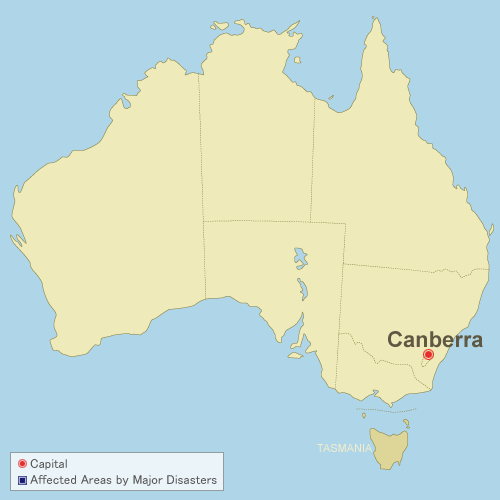TOP PAGE > Information on Disaster Risk Reduction of the Member Countries
Information on Disaster Risk Reduction of the Member Countries
 Australia
Australia
General Information
 Formal Name: Commonwealth of Australia
Formal Name: Commonwealth of AustraliaAustralia is located in the south-west of Oceania. It is comprised of the Australian continent, Tasmania island, Cocos Islands, Norfolk Island, and other numerous islands. The area is 7,692,024 square kilometers. Most of the continent is flat without significant high mountains. The climate of Australia varies widely. The northern part of the country has a tropical climate, the southern part has a temperate climate, and the central and west part has a dry climate.
The capital is Cannberra. Most of the estimated 20.63 million people are European descent. Others are Asian descent and Aboriginal people (the indigenous population).
Overview of Disasters
Forest Fire, Cyclone, Storms, Flood, Flash Flood, Landslides, Tornade, Earthquake, Tsunami, Heat Wave and Drought are main disasters.
Recent Major Disasters
Victorian Bushfire (February 2009)
On and around Saturday 7 February 2009, extreme bushfire caused sever damage in state of Victoria. As of March 6, around 200 people were killed, around 500 injured and more than 2,000 houses were destroyed.
Storm (June 2007)
On 8 June 2007, strong winds and torrential rain triggered by intense low pressure system caused extensive damage in the state of New South Wales in Australia. 10 people were killed and 5,000 were affected. It caused damage of approximately US$1.3 million.
Cyclone Tracy (December 1974)
Tropical Cyclone Tracy struck Darwin in the early hours of 25 December 1974 killed 71 people, injured 650 people, and affected 47,000 people.
Disaster Management System
Legal System
National Strategy for Disaster Resilience is to provide high-level guidance on disaster management to federal, state, territory and local governments, business and community leaders and the not-for-profit sector. While the Strategy focuses on priority areas to build disaster resilient communities across Australia, it also recognises that disaster resilience is a shared responsibility for individuals, households, businesses and communities, as well as for governments.
Organization
The Ministerial Council for Police and Emergency Management (MCPEM) established in 2006 oversees national disaster management, seeking to develop effective collaboration and coordination of federal, state, territory and local government action. The Council guides the strategic direction of emergency management in Australia and meets once a year.
The Australian Emergency Management Committee (AEMC) is the Australia’s peak consultative emergency management forum. This committee comprises chairpersons and executive officers of State and Territory emergency management committees, the Director General of Emergency Management Australia, representatives of the Australian Local Government Association and the New Zealand Director of Civil Defence and Emergency Management.
Emergency Management Australia (EMA) is the agency which is part of the Attorney General's Department and provides the secretariat for MCPEM and AEMC. EMA has responsibility to build key relationships within the national and international emergency management arena and work in partnership with all levels of government, the private sector, and non-government organisations to mitigate the impact of emergency and disaster events. In the face of devastating fires and floods, the Australian Government combined the efforts of the National Recovery and Resilience Agency and Emergency Management Australia, to create the National Emergency Management Agency (NEMA) on 1 September 2022.
The Australian Emergency Management Committee (AEMC) is the Australia’s peak consultative emergency management forum. This committee comprises chairpersons and executive officers of State and Territory emergency management committees, the Director General of Emergency Management Australia, representatives of the Australian Local Government Association and the New Zealand Director of Civil Defence and Emergency Management.
Emergency Management Australia (EMA) is the agency which is part of the Attorney General's Department and provides the secretariat for MCPEM and AEMC. EMA has responsibility to build key relationships within the national and international emergency management arena and work in partnership with all levels of government, the private sector, and non-government organisations to mitigate the impact of emergency and disaster events. In the face of devastating fires and floods, the Australian Government combined the efforts of the National Recovery and Resilience Agency and Emergency Management Australia, to create the National Emergency Management Agency (NEMA) on 1 September 2022.
Plan
The Natural Disaster Mitigation Program (NDMP) was established in 2003-04 and aims to create safer, sustainable communities better able to withstand the effects of floods, storms, bush fires and other rapid onset natural disasters.

